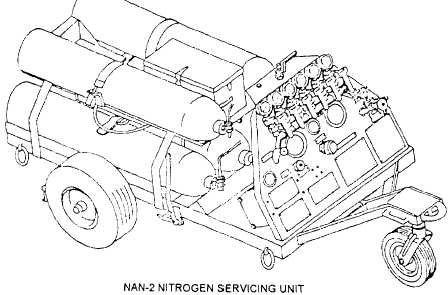

Custom Search
|
|
  |
|
|
DISMOUNTING REMOUNTABLE FLANGE WHEELS. The tire bead should be broken away from the wheel according to the bead-breaking procedure. If the tire has a tube, you should remove the hex nut and push the valve away from the seated position. This will prevent damage to the inner tube valve attachment when you break the bead. If you have trouble removing the flange while the wheel is mounted on the bead-breaking machine, remove the tire from the machine. Lay the tire and wheel assembly flat with the demountable flange side up. Drive the remountable flange down by tapping it with a rubber, plastic, or rawhide-faced mallet. This should enable you to remove the locking ring.CAUTION Extreme care must be taken when you break the beads loose and remove the lockring on some remountable flange wheels. The toe of the remountable flange may extend very close to the tube valve stem. Excessive travel of the remountable flange or of the tire bead may damage the rubber base of the inner tube valve.If the tire is tubeless, remove the wheel seal carefully and place it on a clean surface. Wheel seals in satisfactory condition maybe reused if replacement seals are not available. Turn the tire and wheel assembly over and lift the wheel out of the tire. Remember to keep the wheel flange and locking ring together as a unit to avoid mismatch during remounting.Mounting Prior to mounting a tire on a wheel, you should inspect the tire and ensure the inside of the tire is free of foreign materials. The inner tube must be inspected for bead chafing, thinning, folding, surface checking, heat damage, fabric liner separation, valve pad separation, damaged valves, leaks, and other signs of deterioration.MOUNTING DIVIDED (SPLIT) WHEELS. All wheel halves should be matched by year and month of manufacture as closely as possible. Wheel assemblies received from overhaul that have matching overhaul dates on both rims should be maintained as matched assemblies. In the event a wheel assembly is received or made up of wheel halves having different overhaul dates, the wheel overhaul should be based upon the earlier date. All wheels shouId fit together easily.When you mount a tube tire, dust the tube with talcum powder and insert it in the tire. The tire should be positioned so the balance marker on the tube located next to the balance marker on the tire.NOTE: The balance marker on an inner tube is a stripe of contrasting colors approximately 1/2 inch wide and 2 inches long. It is located on the valve side of the tube. The balance mark on a tire is a red dot approximately one-half inch in diameter. It is located on the sidewall near the bead.You should inflate the tube until it is round, and then place the valve-hole half of the wheel into position in the tire. Push the valve stem through the hole. Finally, insert the other half of the wheel and align the bolt holes.NOTE: All bolts must be magnetic particle inspected to ensure they are not defective. Install four bolts, nuts, and washers 90 degrees apart. Start the bolts by hand, and tighten them evenly until the wheel halves seat. Install the remaining bolts, nuts, and washers. Tighten the bolts in a crisscross order to prevent distorting the wheel or damaging the inserts. A pneumatic-powered impact wrench may be used, provided the torque obtained does not exceed 25 percent of the specified final torque required for the wheel. Use a calibrated torque wrench, and tighten each bolt in increments of 25 percent of the specified torque value in a crisscross order until the total torque value required for each bolt in the wheel has been reached.NOTE: When lubtork is specified on the wheel half, coat all the treads and bearing surfaces of the bolt heads with MIL-T-5544 antiseize compound. Lubtork must not be used on magnesium wheels. For magnesium wheels, you should use MIL-G-21164 lubricant. All excessive lubricant should be removed.Before mounting tubeless tires, check the tire side wall for the word tubless. Tires without this marking should be treated as tube tires. When you mount tubeless tires, install the valve stem (valve core removed) in the wheel assembly. Removing the valve core prevents unseating of the wheel seal by the pressure built up when the tire is installed. Insert one
wheel half in the tire, and position the tire so the balance marker on the tire is located at the valve stem. Install the wheel seal. Be sure the outer wheel half has been lubricated with a light coat of MIL-G-4343 lubricant. Install the other wheel half and align the bolt holes. Install the bolts, washers, and nuts in the same manner used for the wheel assembly containing inner tubes. |
 
|
  |
|